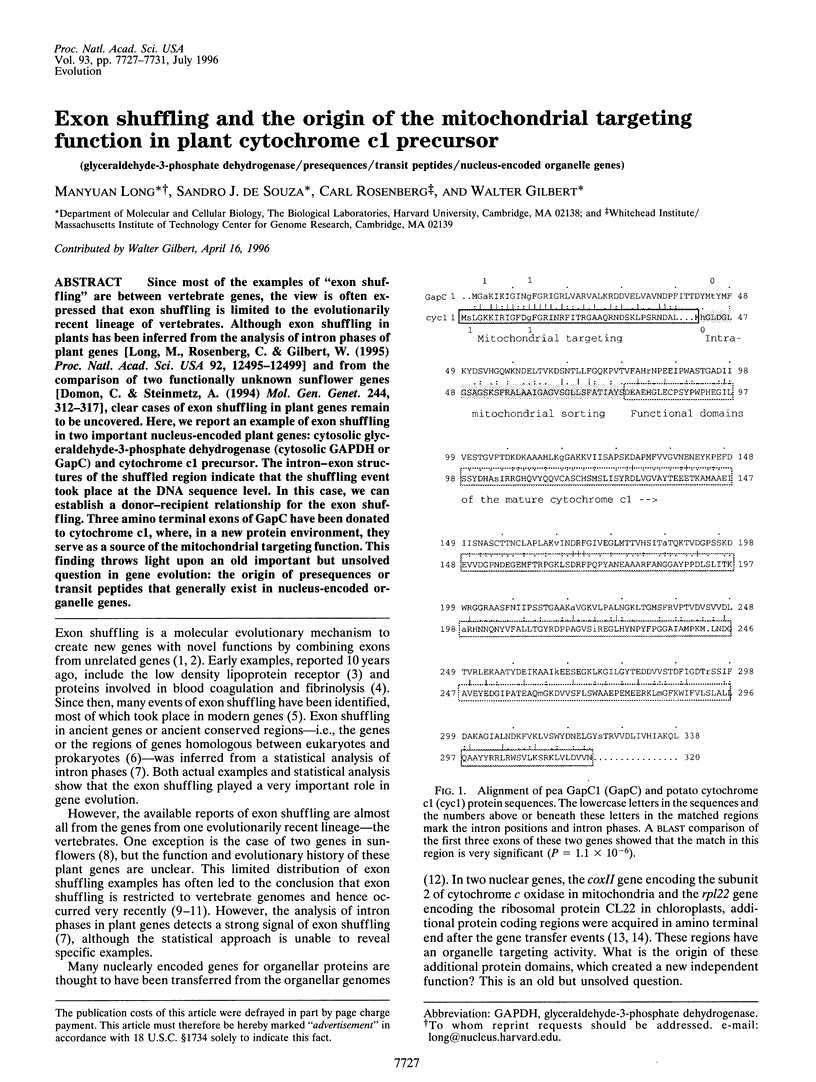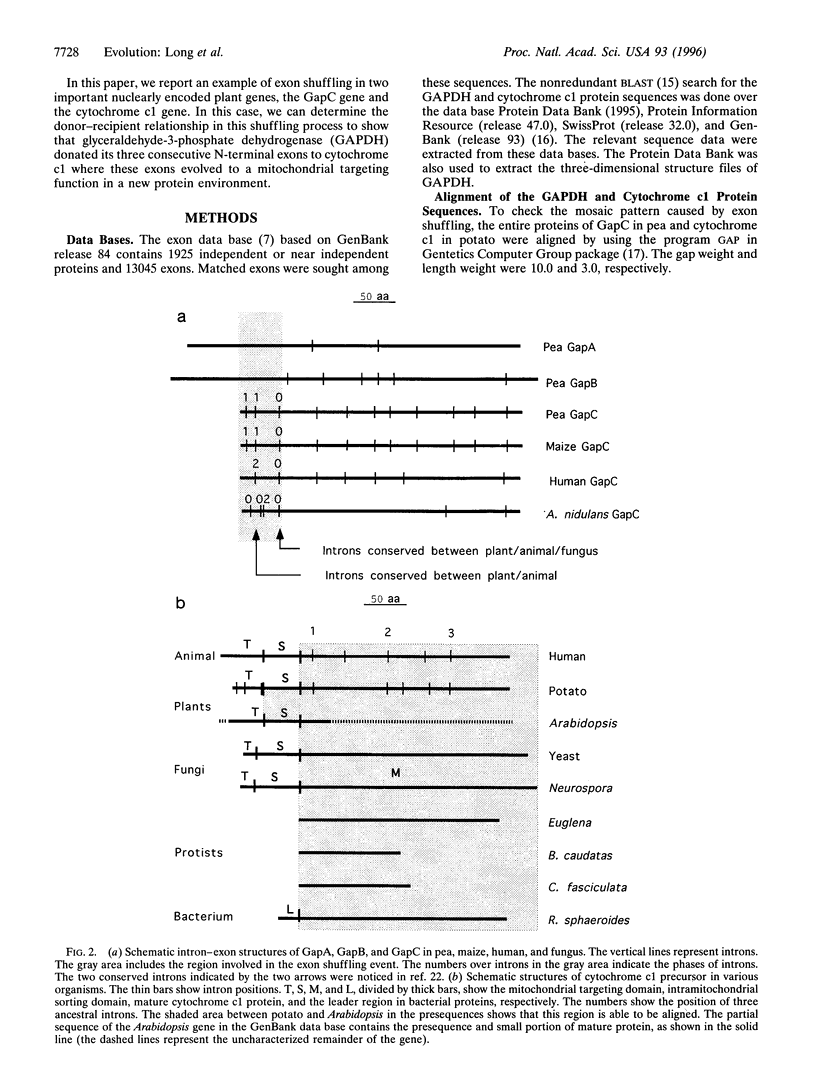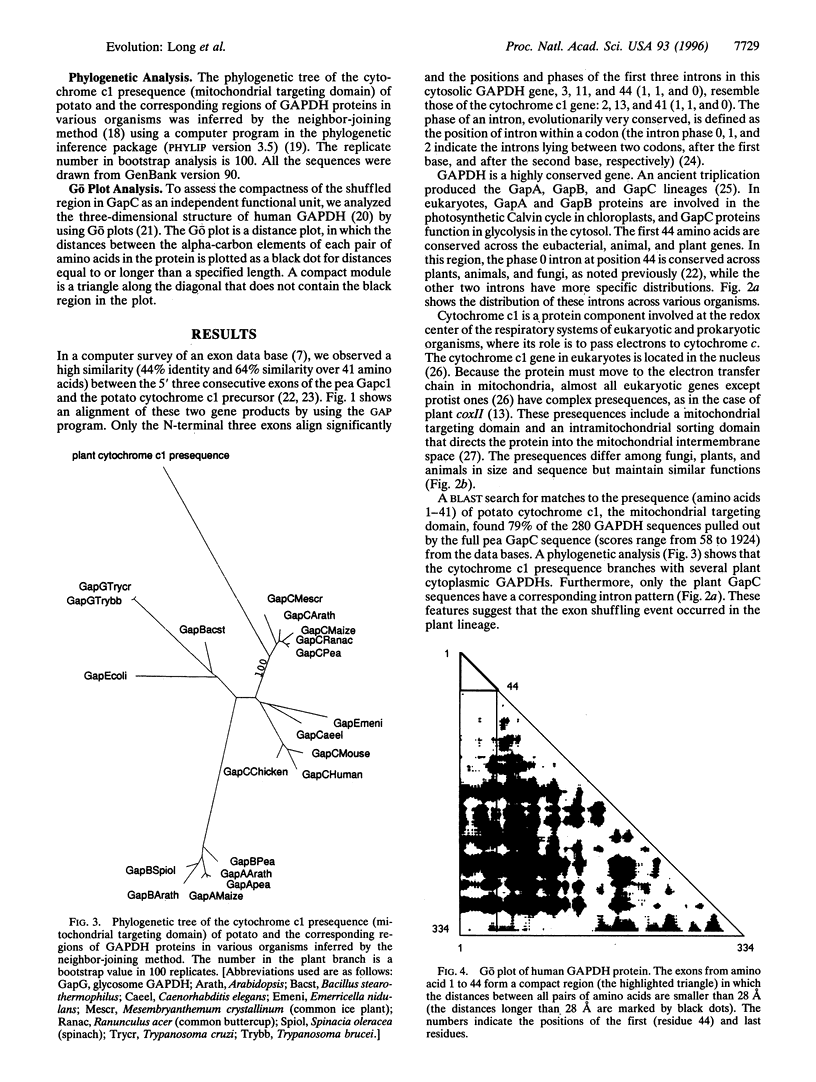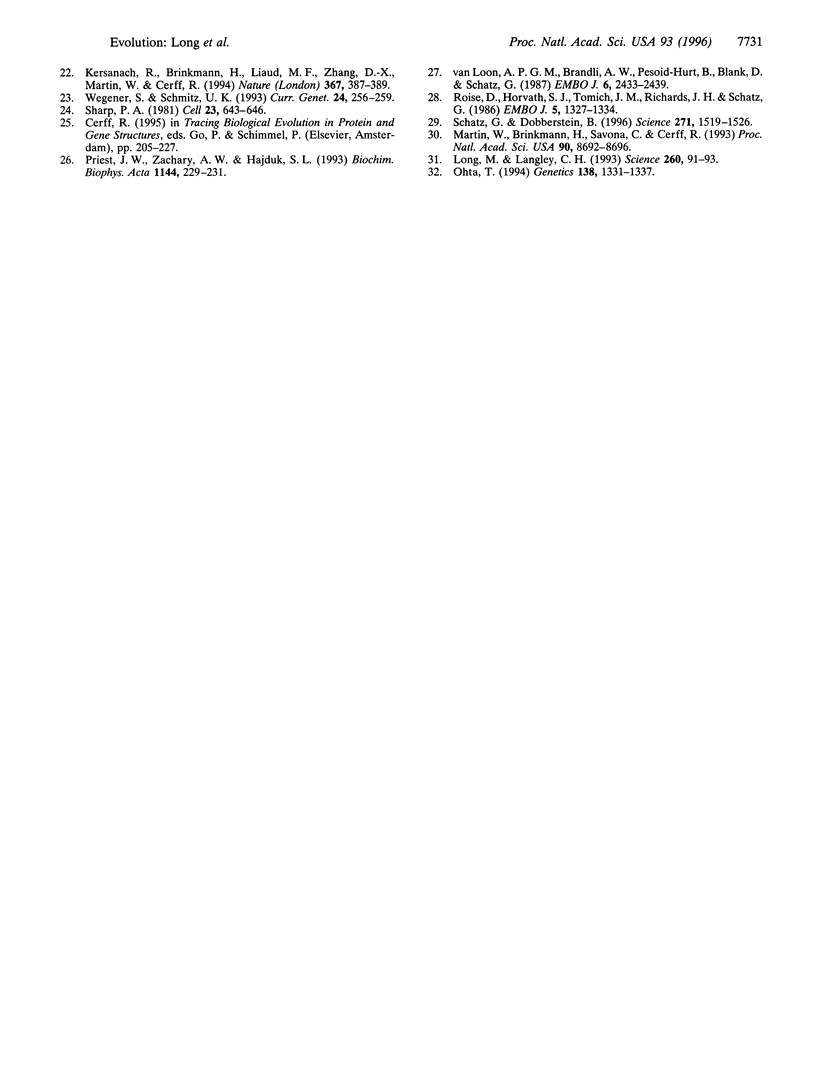Abstract
Since most of the examples of "exon shuffling" are between vertebrate genes, the view is often expressed that exon shuffling is limited to the evolutionarily recent lineage of vertebrates. Although exon shuffling in plants has been inferred from the analysis of intron phases of plant genes [Long, M., Rosenberg, C. & Gilbert, W. (1995) Proc. Natl. Acad. Sci. USA 92, 12495-12499] and from the comparison of two functionally unknown sunflower genes [Domon, C. & Steinmetz, A. (1994) Mol. Gen. Genet. 244, 312-317], clear cases of exon shuffling in plant genes remain to be uncovered. Here, we report an example of exon shuffling in two important nucleus-encoded plant genes: cytosolic glyceraldehyde-3-phosphate dehydrogenase (cytosolic GAPDH or GapC) and cytochrome c1 precursor. The intron-exon structures of the shuffled region indicate that the shuffling event took place at the DNA sequence level. In this case, we can establish a donor-recipient relationship for the exon shuffling. Three amino terminal exons of GapC have been donated to cytochrome c1, where, in a new protein environment, they serve as a source of the mitochondrial targeting function. This finding throws light upon an old important but unsolved question in gene evolution: the origin of presequences or transit peptides that generally exist in nucleus-encoded organelle genes.
Full text
PDF




Images in this article
Selected References
These references are in PubMed. This may not be the complete list of references from this article.
- Altschul S. F., Gish W., Miller W., Myers E. W., Lipman D. J. Basic local alignment search tool. J Mol Biol. 1990 Oct 5;215(3):403–410. doi: 10.1016/S0022-2836(05)80360-2. [DOI] [PubMed] [Google Scholar]
- Devereux J., Haeberli P., Smithies O. A comprehensive set of sequence analysis programs for the VAX. Nucleic Acids Res. 1984 Jan 11;12(1 Pt 1):387–395. doi: 10.1093/nar/12.1part1.387. [DOI] [PMC free article] [PubMed] [Google Scholar]
- Domon C., Steinmetz A. Exon shuffling in anther-specific genes from sunflower. Mol Gen Genet. 1994 Aug 2;244(3):312–317. doi: 10.1007/BF00285459. [DOI] [PubMed] [Google Scholar]
- Gantt J. S., Baldauf S. L., Calie P. J., Weeden N. F., Palmer J. D. Transfer of rpl22 to the nucleus greatly preceded its loss from the chloroplast and involved the gain of an intron. EMBO J. 1991 Oct;10(10):3073–3078. doi: 10.1002/j.1460-2075.1991.tb07859.x. [DOI] [PMC free article] [PubMed] [Google Scholar]
- Gilbert W. The exon theory of genes. Cold Spring Harb Symp Quant Biol. 1987;52:901–905. doi: 10.1101/sqb.1987.052.01.098. [DOI] [PubMed] [Google Scholar]
- Gilbert W. Why genes in pieces? Nature. 1978 Feb 9;271(5645):501–501. doi: 10.1038/271501a0. [DOI] [PubMed] [Google Scholar]
- Go M. Correlation of DNA exonic regions with protein structural units in haemoglobin. Nature. 1981 May 7;291(5810):90–92. doi: 10.1038/291090a0. [DOI] [PubMed] [Google Scholar]
- Green P., Lipman D., Hillier L., Waterston R., States D., Claverie J. M. Ancient conserved regions in new gene sequences and the protein databases. Science. 1993 Mar 19;259(5102):1711–1716. doi: 10.1126/science.8456298. [DOI] [PubMed] [Google Scholar]
- Kersanach R., Brinkmann H., Liaud M. F., Zhang D. X., Martin W., Cerff R. Five identical intron positions in ancient duplicated genes of eubacterial origin. Nature. 1994 Jan 27;367(6461):387–389. doi: 10.1038/367387a0. [DOI] [PubMed] [Google Scholar]
- Long M., Langley C. H. Natural selection and the origin of jingwei, a chimeric processed functional gene in Drosophila. Science. 1993 Apr 2;260(5104):91–95. doi: 10.1126/science.7682012. [DOI] [PubMed] [Google Scholar]
- Long M., Rosenberg C., Gilbert W. Intron phase correlations and the evolution of the intron/exon structure of genes. Proc Natl Acad Sci U S A. 1995 Dec 19;92(26):12495–12499. doi: 10.1073/pnas.92.26.12495. [DOI] [PMC free article] [PubMed] [Google Scholar]
- Long M., de Souza S. J., Gilbert W. Evolution of the intron-exon structure of eukaryotic genes. Curr Opin Genet Dev. 1995 Dec;5(6):774–778. doi: 10.1016/0959-437x(95)80010-3. [DOI] [PubMed] [Google Scholar]
- Martin W., Brinkmann H., Savonna C., Cerff R. Evidence for a chimeric nature of nuclear genomes: eubacterial origin of eukaryotic glyceraldehyde-3-phosphate dehydrogenase genes. Proc Natl Acad Sci U S A. 1993 Sep 15;90(18):8692–8696. doi: 10.1073/pnas.90.18.8692. [DOI] [PMC free article] [PubMed] [Google Scholar]
- Ohta T. Further examples of evolution by gene duplication revealed through DNA sequence comparisons. Genetics. 1994 Dec;138(4):1331–1337. doi: 10.1093/genetics/138.4.1331. [DOI] [PMC free article] [PubMed] [Google Scholar]
- Palmer J. D. Comparative organization of chloroplast genomes. Annu Rev Genet. 1985;19:325–354. doi: 10.1146/annurev.ge.19.120185.001545. [DOI] [PubMed] [Google Scholar]
- Palmer J. D., Logsdon J. M., Jr The recent origins of introns. Curr Opin Genet Dev. 1991 Dec;1(4):470–477. doi: 10.1016/s0959-437x(05)80194-7. [DOI] [PubMed] [Google Scholar]
- Patthy L. Evolution of the proteases of blood coagulation and fibrinolysis by assembly from modules. Cell. 1985 Jul;41(3):657–663. doi: 10.1016/s0092-8674(85)80046-5. [DOI] [PubMed] [Google Scholar]
- Patthy L. Exons--original building blocks of proteins? Bioessays. 1991 Apr;13(4):187–192. doi: 10.1002/bies.950130408. [DOI] [PubMed] [Google Scholar]
- Priest J. W., Wood Z. A., Hajduk S. L. Cytochromes c1 of kinetoplastid protozoa lack mitochondrial targeting presequences. Biochim Biophys Acta. 1993 Sep 13;1144(2):229–231. doi: 10.1016/0005-2728(93)90178-i. [DOI] [PubMed] [Google Scholar]
- Roise D., Horvath S. J., Tomich J. M., Richards J. H., Schatz G. A chemically synthesized pre-sequence of an imported mitochondrial protein can form an amphiphilic helix and perturb natural and artificial phospholipid bilayers. EMBO J. 1986 Jun;5(6):1327–1334. doi: 10.1002/j.1460-2075.1986.tb04363.x. [DOI] [PMC free article] [PubMed] [Google Scholar]
- Saitou N., Nei M. The neighbor-joining method: a new method for reconstructing phylogenetic trees. Mol Biol Evol. 1987 Jul;4(4):406–425. doi: 10.1093/oxfordjournals.molbev.a040454. [DOI] [PubMed] [Google Scholar]
- Schatz G., Dobberstein B. Common principles of protein translocation across membranes. Science. 1996 Mar 15;271(5255):1519–1526. doi: 10.1126/science.271.5255.1519. [DOI] [PubMed] [Google Scholar]
- Sharp P. A. Speculations on RNA splicing. Cell. 1981 Mar;23(3):643–646. doi: 10.1016/0092-8674(81)90425-6. [DOI] [PubMed] [Google Scholar]
- Stoltzfus A., Spencer D. F., Zuker M., Logsdon J. M., Jr, Doolittle W. F. Testing the exon theory of genes: the evidence from protein structure. Science. 1994 Jul 8;265(5169):202–207. doi: 10.1126/science.8023140. [DOI] [PubMed] [Google Scholar]
- Südhof T. C., Russell D. W., Goldstein J. L., Brown M. S., Sanchez-Pescador R., Bell G. I. Cassette of eight exons shared by genes for LDL receptor and EGF precursor. Science. 1985 May 17;228(4701):893–895. doi: 10.1126/science.3873704. [DOI] [PubMed] [Google Scholar]
- Wegener S., Schmitz U. K. The presequence of cytochrome c1 from potato mitochondria is encoded on four exons. Curr Genet. 1993 Sep;24(3):256–259. doi: 10.1007/BF00351800. [DOI] [PubMed] [Google Scholar]
- van Loon A. P., Brändli A. W., Pesold-Hurt B., Blank D., Schatz G. Transport of proteins to the mitochondrial intermembrane space: the 'matrix-targeting' and the 'sorting' domains in the cytochrome c1 presequence. EMBO J. 1987 Aug;6(8):2433–2439. doi: 10.1002/j.1460-2075.1987.tb02522.x. [DOI] [PMC free article] [PubMed] [Google Scholar]




